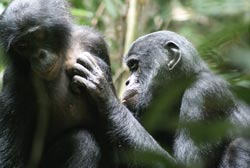Bonobos‘ unusual success story

Bonobos grooming each other in Lui Kotale, Salonga National Park, Democratic Republic of Congo. © Caroline Deimel/Lui Kotale Bonobo Project <br>
Mate competition by males over females is common in many animal species. During mating season male testosterone levels rise, resulting in an increase in aggressive behavior and masculine features.
Male bonobos, however, invest much more into friendly relationships with females. Elevated testosterone and aggression levels would collide with this increased tendency towards forming pair-relationships.
Bonobos are among the closest living relatives of humans. Like other great apes they live in groups made up of several males and females. Contrary to other ape species however, male bonobos do not, in general, outrank female individuals and do not dominate them in mating contexts.
This constellation suggests that the selection for typically masculine behavioral patterns like aggression, dominance and intrasexual competition are met with antagonistic forces: On one hand it is advantageous if a male outcompetes a fellow male.
This, however, implies that there is increased aggression and an elevated level of testosterone in high-ranking males. On the other hand – as dominance relations between the sexes are rather balanced in bonobos – it is likely that males benefit from having friendly pair-relationships with female individuals.
Studies with birds and rodents show that a tendency towards forming pair-relationships correlates with lower male aggression rates and testosterone levels.
In a current study, Martin Surbeck, Gottfried Hohmann, Tobias Deschner and colleagues of the Max Planck Institute for Evolutionary Anthropology in Leipzig, Germany, found that in wild bonobos high-ranking males were more aggressive and their mating success was higher when compared to lower-ranking males.
Contrary to other species in which males compete fiercely over access to females, there was no correlation between dominance status or aggression with testosterone levels. In addition, the researchers found that high-ranking males invested more often than lower-ranking group members into friendly relationships with females. This suggests that these friendly relationships between the sexes are associated with lower male testosterone levels.
“Our study suggests that in bonobos – as in in humans – intersexual friendships result in hormonal patterns that we know from species in which male individuals are actively participating in raising their young and in which the two sexes enter lasting pair-relationships“, says Martin Surbeck.
Contact
Dr. Tobias Deschner
Dept. of Primatology
Max Planck Institute for Evolutionary Anthropology, Leipzig
Phone: +49 341 3550-207
Email: deschner@eva.mpg.de
Sandra Jacob
Max Planck Institute for Evolutionary Anthropology, Leipzig
Phone: +49 341 3550-122
Fax: +49 341 3550-119
Email: jacob@eva.mpg.de
Publication reference
Martin Surbeck, Tobias Deschner, Grit Schubert, Anja Weltring, Gottfried Hohmann
Mate competition, testosterone and intersexual relationships in bonobos (Pan paniscus)
Animal Behavior, January 9, 2011
Media Contact
More Information:
http://www.mpg.de/4994603/Bonobos_testosteroneAll latest news from the category: Life Sciences and Chemistry
Articles and reports from the Life Sciences and chemistry area deal with applied and basic research into modern biology, chemistry and human medicine.
Valuable information can be found on a range of life sciences fields including bacteriology, biochemistry, bionics, bioinformatics, biophysics, biotechnology, genetics, geobotany, human biology, marine biology, microbiology, molecular biology, cellular biology, zoology, bioinorganic chemistry, microchemistry and environmental chemistry.
Newest articles

Bringing bio-inspired robots to life
Nebraska researcher Eric Markvicka gets NSF CAREER Award to pursue manufacture of novel materials for soft robotics and stretchable electronics. Engineers are increasingly eager to develop robots that mimic the…

Bella moths use poison to attract mates
Scientists are closer to finding out how. Pyrrolizidine alkaloids are as bitter and toxic as they are hard to pronounce. They’re produced by several different types of plants and are…

AI tool creates ‘synthetic’ images of cells
…for enhanced microscopy analysis. Observing individual cells through microscopes can reveal a range of important cell biological phenomena that frequently play a role in human diseases, but the process of…





















